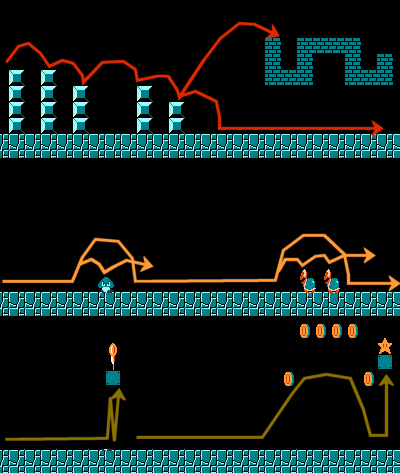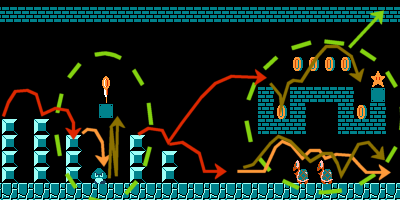As the Workshop continues to create collaborative courses together, we also cover a design topic each week. Every topic from this point forward is a high level topic. Without the fundamental concepts of game design and a clear language to articulate ideas, these high level topics would be incomprehensible. To kick things off we learned about LAYERS.
The term "layer" is as generic as it sounds. The earth has layers, cakes have layers, croissants, onions, and even ogres have layers. They key to creating a layers is in its relation to the other elements in the set. A layer cake, for example, can be created entirely out of vanilla cake, but in between each slice, there must be something else. Perhaps chocolate frosting. This brings us to the three key elements of a layer.
- A layer must be distinct from its neighbors.
- A layer must be part of the whole or set.
- A layer must accessible simultaneously with its neighbors.
When it comes to level design, layers typically have to be interactive. In other words, we're looking for distinct gameplay ideas that are part of a single course, and can be experienced simultaneously. Remember that a gameplay idea can be as extravagant as escaping from jail with a Koopa as your partner, or as simple as jumping off of bullet bills to cross a gap.
You already know How Layers work
Super Mario Bros. style level design features multiple layers. Compared to platformers like Super Meat Boy or Celeste, Mario gameplay has a lot more dynamic, emergent gameplay possibilities that create distinct layers. The basic layout of a traditional Mario course can be a challenge in and of itself. Assignment #1 proved that when the Workshop created courses only using blocks. For extra credit, we added either coins, enemies, or a power up to these block-only courses to see just how big of a difference each type of element makes. In conclusion, it's a big difference.
Coins define traversal spaces, create new challenges, and can encourage the player to explore.
Enemies threaten traversal spaces, create new challenges, have interplay, and react dynamically to the environment.
Power ups give Mario new abilities that change the way he moves and fights.
These layers make up the core of Mario level design. Recall how you can navigate through a level, defeat enemies, and grab coins all at the same time. Or you can do these things separately. That's the inherent power of layered level design; giving players the flexibility to change their gameplay experience even when playing the same level repeatedly.
Layers of Depth
Layers are a good way to think about level design depth. If the goal of a level is to present the player with challenges that require skill to overcome, then successfully layering in as many different challenges as possible is a way for a level to "do more of its job." As long as the final result is playable and coherent, the level is as deep as its layers are varied.
Depth is the meaning conveyed through a work, and it is measured the same way for other mediums. A poem isn't deep because it conveys a clear idea without ambiguity. That's what we call instructions. Poems are deep when they can express precise experiences somewhat indirectly using poetic form and figures of speech. So "I am mad today at work" is not a fantastic line of poetry. While "I punched in the clock at work without my timecard" is rich and complex because it plays off the idea of jobs using "punch clocks" to measure employee work hours. It uses the figure of speech "punch the clock" which means to check in; yet the speaker physically punches the check in device. The latter version is more subtle because it relies on the reader using their knowledge of the real world to imagine the scene to then figure out how the speakers actions relate to the "mad" mood.
Creating depth with fewer complexities (e.g. level elements, ingredients, words, etc.) is partially how we determine excellence in design. However, being efficient doesn't add any new ideas or any additional meaning to the work.
Video games can create play spaces with staggering, near infinite unique gameplay possibilities. Sure, most of these possibilities are trivially similar, but the point still stands. Level design is complex because of how each element relates to each other. Just by rearranging elements in a given course it is possible to create new layers and add additional, distinct gameplay possibilities. By understanding design and various playstyles, we can design courses to contain extra meaning for players looking for it.
Secrets are a layer, albeit a hidden one, that exist in a level. Making a level an interesting and challenging experience for speedrunning is another type of layer. And sometimes, new gameplay ideas can be created when players go back and forth interacting with a courses layers. This is called counterpoint. We will cover that concept in the weeks to come.
The following is a Workshop Recap video where @KirbyKid explains layers.

